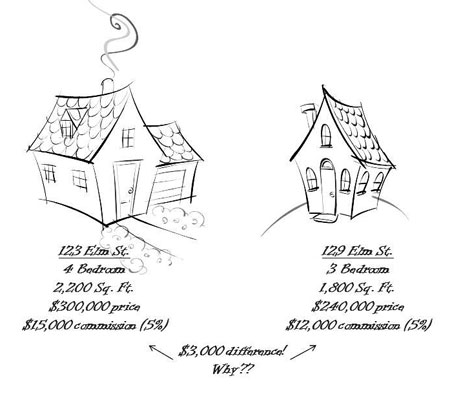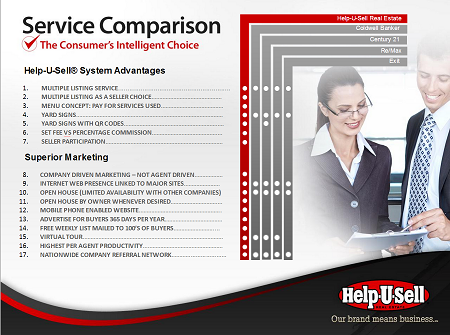Most traditional real estate brokers – what I like to call ‘ordinary’ brokers – charge a percentage of a property’s sale price as commission. It’s been that way for . . . well, for as long as anyone can remember. It’s what we do because . . . it’s just what we do. To question it would be like questioning why we eat three meals a day or why we go to bed at night. So, while percentage based commissions irritate real estate consumers to no end, they are rarely challenged. Here at the Set Fee Blog, we challenge them every day. We believe the future of real estate will be better for consumers who will pay a logical (lower) set fee to market their property.
Let’s take a breath here in the Spring of 2013 to, once again, chip away at that tired old percentage based paradigm. Let’s take a look at why percentage based real estate commissions make no sense.*
REASON ONE: Percentage based commissions are arbitrary
In my examples I am using 5%. But why? What does 5% of the sale price have to do with what it takes to get the property sold? What does it have to do with effective representation of the seller’s interest and the effectiveness of processing the sale? Nothing. It’s just a number I pulled out of the air, remember? And that’s how ordinary brokers set their commission rates: they usually just pull them out of air. There is no connection between the fee charged and the level of effort and resources it will take to sell the property.
From an ordinary broker’s perspective, the arbitrary percentage based commission is full of possibilities! Because it is a percent of the sale price, the amount of dollars collected in commission goes up as more and more expensive property sells! A typical strategy for an ordinary broker who wants to improve his/her bottom line is to target ever more expensive property . . . because 5% of $500,000 is a heck of a lot more than 5% of $300,000 . . . and, honestly? It usually takes no more time, effort, energy or money to market a $500,000 home than a $300,000 home. Yea! Let’s hear it for arbitrary commission rates!
REASON TWO: Percentage based commissions are inequitable
Let’s assume you want to sell your $300,000 house. It’s a nice big 4 bedroom with 2,200 square feet of living space. You decide to list with a fictitious company, Hypothetical Realty, and agree to pay their 5% commission when the property sells. That’s $15,000 (Gulp!).
(Wait a minute . . . I’m having trouble catching my breath . . . I’m thinking about YOU in your $300,000 house. If you are a typical $300,000 house homeowner, you might earn in the neighborhood of $80,000 a year. That means YOU, the owner of this house has to work about 2 1/2 months to pay your real estate commission! Really: take your paychecks for January, February and half of March and give them to your real estate broker because that’s what it’s going to cost to sell your house! )
Now, when your neighbor sees the For Sale sign in your yard, he starts to thinking . . . ‘maybe this is a good time for ME to sell.’ So he calls up Hypothetical Realty, has them over for a chat and agrees to pay their 5% commission, too. But his house is smaller: it’s just 3 bedrooms and 1,800 square feet. Price: $240,000. If it sells for full price, the commission will be $12,000.

Wait a minute! You’re paying $15,000 for the same service delivered by the same company that your neighbor is paying just $12,000 for!?! WHY?? Where is the logic in that?? Are you paying $3,000 more because it will take that much more advertising to get the job done? (Hardly) Are you paying $3,000 more for a better For Sale sign?? Oh, I know: you’re paying $3,000 more because your agent is going to work $3,000 harder, right? WRONG! There is absolutely no reason why you’re paying $3,000 more than your neighbor other than this: you’ve been conditioned from the moment you had your first real estate transaction to accept without question the notion that real estate commissions should be a percentage of the sale price.
Usually it takes no more time, energy effort or money to sell a $300,000 house than a $250,000 house in the same neighborhood. So why aren’t they paying the same thing? I really have no explanation. I think, next time you talk with Hypothetical Realty, you might want to ask them.
REASON THREE: Percentage based commissions are inflexible
Ok. You listed with Hypothetical, remember? They are selling your $300,000 house and charging 5%. The reason the fee is so high is that in all likelihood there will be TWO real estate companies involved in the transaction – yours (the listing company), and a different company who comes in with the buyer. Both companies will need to be paid. And, of course, each of those companies will be represented by an agent who needs to be paid, too. So that 5% you agreed to pay is not just one commission, it’s four: one for the listing company, one for the listing agent, one for the selling company and one for the selling agent. Ok, maybe there is some logic in this lofty commission stuff after all! There are a lot of people who have to get paid!
But wait: what if your listing company finds the buyer? What if there is no outside broker involved? Do you still have to pay all four commissions? Yep. That’s what you agreed to when you signed the listing agreement. So what does the listing broker do with the extra cash he got to keep? Well in other industries it’s called overage or breakage . . . and it’s one of the keys to pocketability . . oops, I mean profitability.
Or, how about this sad tale: you list your home with Hypothetical on Friday and on Monday you meet the new person transferring into your company from out of state. They hear about your house, fall in love with it and want to buy it. You call up your agent to write it up. Now YOU found the buyer, right? Are you still going to have to pay all four commissions? Yep. That’s what you agreed to when you signed the listing agreement.
You see, there is no connection between what it takes to make the sale and what you’ll pay. It is a completely inflexible, one-size-fits-all system that, I’m sure you agree, makes no sense.
I could go on, but I think three reasons why percentage real estate commissions make no sense is enough. It’s important that you know that it doesn’t have to be this way. There are alternatives out there, though they can be hard to find. One I know and believe in is Help-U-Sell. They charge a logical Set Fee to sell your house. It’s just a wild guess on my part, but that $300,000 house? The one Hypothetical was going to charge 5% or $15,000 to sell? Help-U-Sell Theoretical Realty (a fictitious company operating in the same fictitious neighborhood) might charge something like $3,950 to sell it. Oh, and they’d charge your neighbor with the $250,000 house the same $3,950.
Now I want to be completely clear about this. That $3,950 is this particular Help-U-Sell office’s Set Fee. It covers the consultation and advice you’ll be getting, the marketing of the home, the negotiation, representation and transaction processing you’d expect from any Full Service real estate broker.
What it does not include is any commission for an outside broker or agent. You don’t have to offer it for sale through outside agents, and in some hot markets, that might be advisable. I mean if you can sell without paying extra people, why do it, right? However, most sellers opt to go into the local MLS which means agreeing to pay outside brokers and agents a fee if they bring in the buyer. So you’ll be adding their fee to your Help-U-Sell $3,950 in the event that’s how the sale is made. How much would it be? For your $300,000 house, you might offer between $6,000 and $9,000 to compete for an outside broker or agent’s attention, but the amount you offer is entirely up to you.
And here’s the best part: suppose you do want to offer your home for sale through outside brokers as well, you go into the MLS and you offer to pay an additional, say, $7,500 to an outside broker should they find the buyer . . . but then, you go to your office and, as in the example above, you find your own buyer. What do you pay? Just the Help-U-Sell Set Fee, $3,950. You see, with Help-U-Sell, you pay a fee based on how your home actually sells – with or without outside broker help – not based on an arbitrary percentage based commission that was intended to compensate four different entities.
*In this Blog post, I will be using examples of percentage based commissions. For convenience sake, I’m going to use 5% as the commission rate. It is a number I plucked from air and is in fact a rather unusual number in today’s real estate universe: most charge more. It is important to remember that real estate commissions, whether percentage based or set fee, are fully negotiable between the broker and the consumer. There is no ‘going rate,’ and each situation is (theoretically) handled differently. Brokers set commission rates for their individual offices and if rates are negotiated, they are done so only with the broker’s approval. Price fixing occurs when two or more brokers get together and agree to charge the same thing. That is a highly illegal activity. At Help-U-Sell, different offices charge different set fees for a very logical reason: the cost of carrying a listing varies from location to location as does the number of days it takes to get a listing sold.

 (Note: this is a generic version of the chart used only as an example in Help-U-Sell training. Don’t try to draw any conclusions from this example – it’s totally fictitious) John has used it effectively for years – in fact, it is the centerpiece of his Listing Consultation. It graphically illustrates what his office does for sellers and compares it with what his four biggest competitors do. And, of course, it shows that he does everything they do plus a lot more. It neutralizes the ‘less than Full Service’ bomb quite effectively. Trouble is: you have to get face to face with a seller before you can use it – and if Suzy Sixpence has gotten to them first . . . .well, you may not get the opportunity.
(Note: this is a generic version of the chart used only as an example in Help-U-Sell training. Don’t try to draw any conclusions from this example – it’s totally fictitious) John has used it effectively for years – in fact, it is the centerpiece of his Listing Consultation. It graphically illustrates what his office does for sellers and compares it with what his four biggest competitors do. And, of course, it shows that he does everything they do plus a lot more. It neutralizes the ‘less than Full Service’ bomb quite effectively. Trouble is: you have to get face to face with a seller before you can use it – and if Suzy Sixpence has gotten to them first . . . .well, you may not get the opportunity.